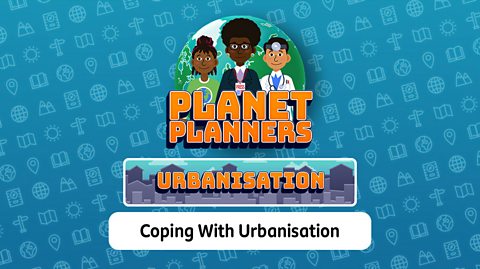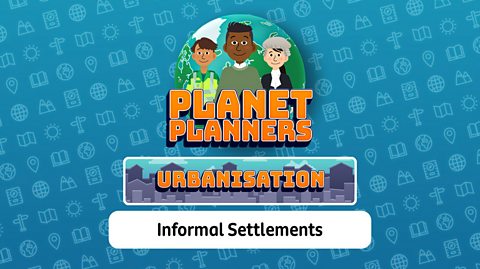What do you know?
Why do people choose to live in cities?
Cities have lots of jobs and so many people move to cities to find work. The cities in low income countries (LICs) and middle income countries (MICs) also have better access to health care and education than the surrounding countryside.
Key points
- Cities in low income countries (LICs) and middle income countries (MICs) are growing through rural to urban migrationThe movement of people from the countryside to cities. This often takes place in LICs, where people move to cities in search of better opportunities.. Many migrants live in informal settlementUnplanned housing constructed on the edge of cities in LICs..
- Although many cities in LICs and MICs are now important economic hubPart of a country or city that generates a lot of money., the poorest people still do not benefit from the increased wealth. Poorer residents often live in overcrowded informal settlements.
- Cities in LICs and MICs have many challenges that require management. These include poor quality housing, lack of clean water and sanitation, access to health services and education, and meeting energy needs.
Game - Coping with urbanisation
Play a Planet Planners mission to help people deal with the issues that urbanisation brings.
You can also play the full game
How are cities in LICs and MICs changing?
Living conditions
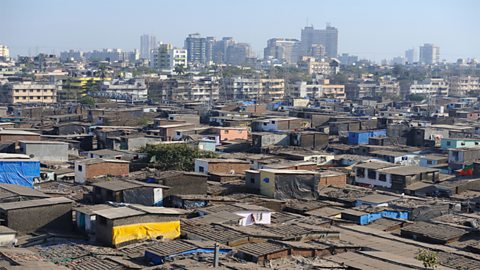
Rates of urbanisationWhen somewhere becomes more urban. This means a greater percentage of people live in cities and towns rather than the countryside. are higher in low income countries (LICs)Countries recognised by the World Bank as having a lower income than other countries. This classification is reviewed yearly. and middle income countries (MICs)Countries recognised by the World Bank as being neither high income or low income. This classification is reviewed yearly. than in other countries. Migrants moving from rural to urban areas sometimes build informal settlementUnplanned housing constructed on the edge of cities in LICs. on marginalisedLand that is less valuable. It may be steep, polluted or at risk of flooding or landslides. land around the edge of the city. These have improved over time and many, such as Iwaya in Lagos, are now well-establishedWhen something has existed for a long period of time and is functioning successfully.neighbourhoodsAreas where people live. .
In some countries, governments have granted residents ownership of the land, and have installed water and sanitation systems. This can be seen in Dharavi, where India's largest community toilet block opened in 2022. The two-storey building provides 111 toilets, a clean water supply, and bathing and laundry facilities.

The economy
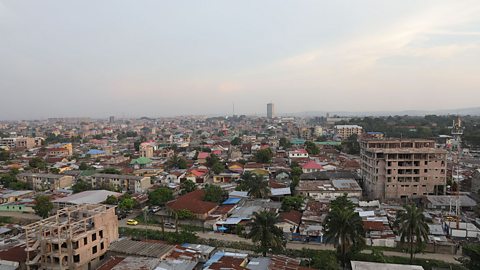
Many cities in LICs and MICs are now important economic hubs. Kinshasa, the capital city of the Democratic Republic of Congo (DRC), is home to offices, banks, government buildings and shopping malls. industryOften refers to factories, but can mean any form of employment that makes money. producing things like textiles and footwear contribute to the city's economyAssociated with money. A country or city’s economy refers to the amount of money that the country or city can make..

However, inequalityWhen people do not have the same opportunities or access to things like jobs and resources. in many LIC and MIC cities is still an ongoing problem. Many wealthier residents live in expensive gated communitySecure housing developments with controlled access. In LICs, gated communities are places where wealthier residents live. whereas poorer residents live in overcrowdedWhen too many people live in one place. informal settlements.
Video: How is Freetown changing?
Discover how Freetown is changing.
Voiceover: How is Freetown changing?
Hi, I'm Mohammed. I come from Freetown, which is the capital of Sierra Leone in West Africa.
Like most cities in low income countries, Freetown is growing fast. As the population increases there are many challenges. But there are many positive changes too. I remember, when I was in Freetown, it wasn't always possible to access clean water. Taps would only work at a certain time of the day.
Now the mayor and Freetown City Council are making access to water a priority. One example of this is a project to collect rainwater in settlements, markets, health centres and schools. The systems are quick and simple to set up. It just needs a pipe to connect from the guttering to the water tank. And they make use of a natural resource: rain!
In Sierra Leone, we have a rainy season that lasts five months. So collecting rainwater is a practical way to work with the environment. Improving access to water can make people's lives better in so many ways.
Question
How have informal settlements in LICs and MICs changed over time?
Many informal settlements in LICs and MICs have improved over time to become well-established neighbourhoods. In some countries, residents have been given ownership of the land they live on. Some informal settlements now have water and sanitation systems. Dharavi in Mumbai has benefitted from toilet blocks and better sewage disposal.
Game - Informal settlements
Play a Planet Planners mission to help make life easier for the residents of informal settlements.
You can also play the full game
Quiz: Changing cities in LICs and MICs
Challenges in LIC and MIC cities
LIC and MIC cities have many challengeThings that are difficult to manage, for example traffic in cities. that require management. Some of these include:
Overcrowding and poor-quality housing
Granting ownershipWhen people have the legal right to something. For example, ownership of land means that the land belongs to you and no one can tell you to leave. of the land enables residents to improve their homes. Improving life for those in rural areas helps to decrease rates of rural to urban migrationThe movement of people from the countryside to cities. This often takes place in LICs, where people move to cities in search of better opportunities..
Clean water and sanitation

Many homes do not have water or toilets. Some governments and charities have provided water and sanitationAccess to clean water and sewage disposal.. These are often in the form of shared standpipeA vertical pipe that transports water from beneath the ground to where it is needed. and toilet blocks.

Access to schools and education
Schools and hospitals can become overwhelmed due to high levels of migration to an area. Building more of these can help to resolve this issue, but they cost a lot of money.
Meeting energy needs
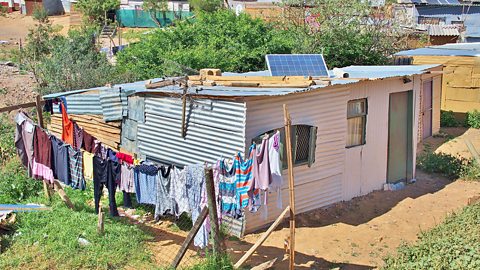
Many people rely on solid fuelThings like wood, charcoal, coal and dung that can be burned to provide heating or for cooking. or keroseneAn oil that can be used for heating and cooking in the home. Kerosene is sometimes known as paraffin. It is most likely to be used in homes in LICs. to meet their energy needs. This can cause health problems, such as lung conditions. Some governments have provided electricity connections to poorer areas. Affordable solar panelA panel designed to convert the heat from the sun to heat water or generate electricity. have also been developed for use in cities.

Informal employment
Many people in LICs and MICs cities work in informal employmentPart of the economy that is neither taxed or monitored. . This means that it is harder for the government to afford setting up services and roads, water pipes, ports and even buildings such as schools and hospitals.
Question
Why is it difficult to build new schools and hospitals in LIC and MIC cities?
New schools and hospitals cost a lot of money to build and maintain over many years. This is even more difficult if the country has a low income or many of its citizens work in informal employment.
Quiz: Challenges in LIC and MIC cities
Play the Planet Planners game! gamePlay the Planet Planners game!
Make decisions for the planet in this KS3 geography game.

More on Urbanisation
Find out more by working through a topic
- count1 of 4
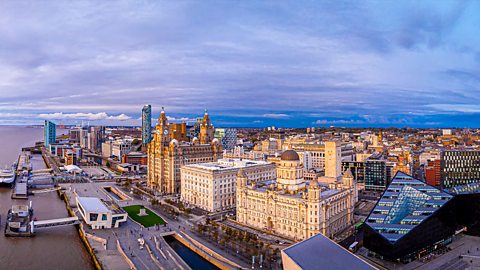
- count2 of 4

- count3 of 4

